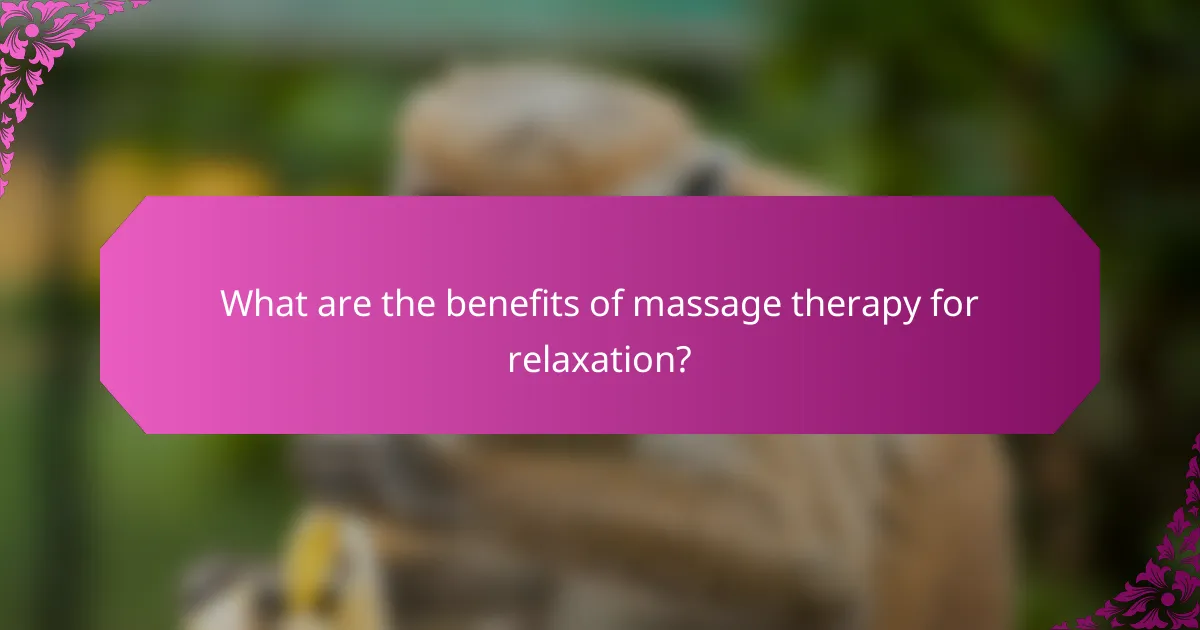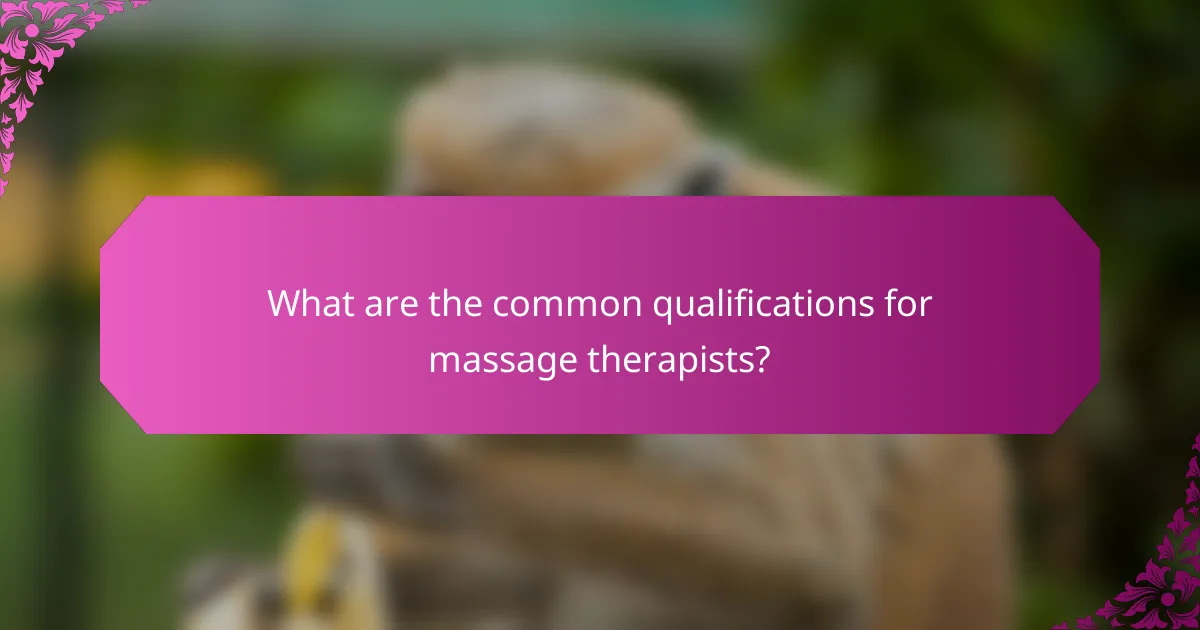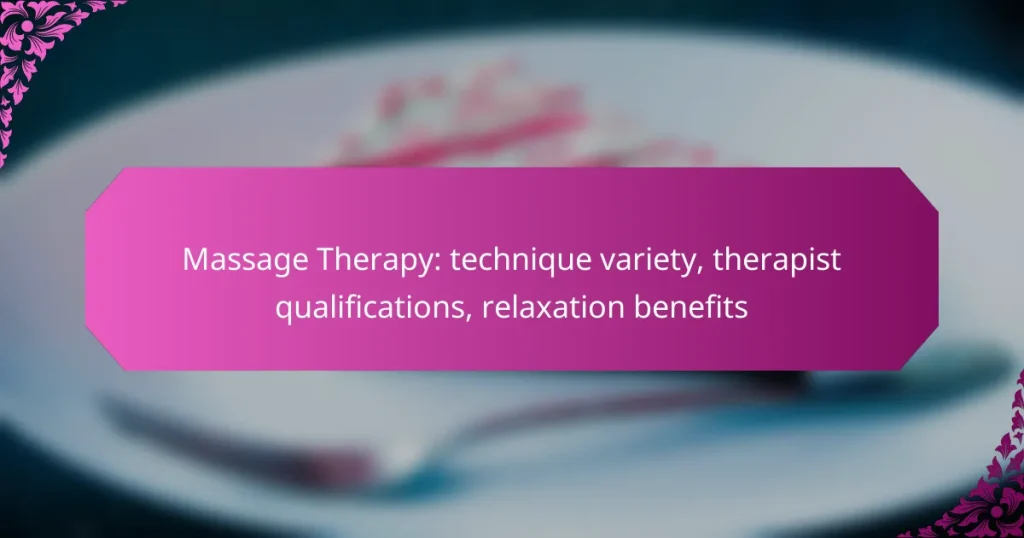Massage therapy in Los Angeles encompasses a variety of techniques tailored to meet individual needs, from relaxation to injury recovery. Selecting a qualified therapist involves checking certifications, reading reviews, and assessing their experience to ensure you receive the best care. The relaxation benefits of massage are profound, as it alleviates muscle tension and fosters a sense of calm, significantly enhancing overall well-being.

What types of massage therapy are available in Los Angeles?
Los Angeles offers a diverse range of massage therapy techniques, each designed to address specific needs and preferences. From relaxation to injury recovery, these therapies cater to various clientele looking for relief and rejuvenation.
Swedish massage
Swedish massage is one of the most popular forms of massage therapy in Los Angeles, focusing on relaxation and overall well-being. It employs long, flowing strokes, kneading, and gentle circular movements to enhance circulation and relieve tension.
This technique is ideal for those new to massage or seeking a calming experience. Sessions typically last between 60 to 90 minutes, allowing ample time for the therapist to address individual areas of concern.
Deep tissue massage
Deep tissue massage targets deeper layers of muscle and connective tissue, making it effective for chronic pain and stiffness. Therapists use slower strokes and more intense pressure to reach the underlying muscles and fascia.
It’s recommended for individuals with specific pain points or those recovering from injuries. Sessions can be intense, so communicating comfort levels with the therapist is crucial.
Sports massage
Sports massage is tailored for athletes and active individuals, focusing on preventing and treating injuries. It combines techniques from Swedish and deep tissue massages to enhance performance and aid recovery.
This type of massage is often scheduled before or after athletic events and can vary in duration based on the athlete’s needs, typically ranging from 30 to 90 minutes.
Hot stone massage
Hot stone massage involves the use of heated stones placed on specific points of the body to promote relaxation and ease muscle tension. The warmth of the stones helps to increase blood flow and alleviate stress.
Sessions usually last around 60 to 90 minutes, and clients should inform their therapist about any heat sensitivity. This technique is particularly beneficial for those seeking a soothing experience.
Aromatherapy massage
Aromatherapy massage combines the therapeutic benefits of massage with essential oils to enhance relaxation and emotional well-being. Different oils are used based on individual preferences and desired outcomes, such as calming or invigorating effects.
Sessions typically last between 60 to 90 minutes, allowing for a personalized experience. It’s important to discuss any allergies or sensitivities to oils with the therapist beforehand.

How do I choose a qualified massage therapist in Los Angeles?
To choose a qualified massage therapist in Los Angeles, start by verifying their certifications and licenses, reading client reviews, and evaluating their experience and specialties. This approach will help ensure you find a skilled professional who meets your specific needs.
Check certifications and licenses
In California, massage therapists must hold a valid license issued by the California Massage Therapy Council (CAMTC). Check if the therapist has completed a minimum of 500 hours of training from an accredited school, which is a common requirement for licensure.
Additionally, look for certifications in specific techniques, such as Swedish, deep tissue, or sports massage. These credentials can indicate a therapist’s expertise in particular areas, enhancing your overall experience.
Read client reviews
Client reviews can provide valuable insights into a therapist’s skills and professionalism. Look for feedback on platforms like Yelp, Google, or specialized massage therapy directories.
Pay attention to comments about the therapist’s technique, communication style, and overall atmosphere of the practice. A high number of positive reviews can be a strong indicator of quality service.
Evaluate experience and specialties
Consider the therapist’s years of experience and their areas of specialization. Some therapists may focus on relaxation techniques, while others might have expertise in therapeutic or rehabilitative massage.
When contacting a therapist, ask about their experience with specific conditions or techniques that interest you. This will help you find someone who can tailor their approach to your individual needs and preferences.

What are the benefits of massage therapy for relaxation?
Massage therapy offers numerous benefits for relaxation, primarily by reducing tension in the muscles and promoting a sense of calm. This holistic approach can significantly enhance mental and physical well-being, making it a popular choice for stress relief.
Reduces stress and anxiety
Massage therapy effectively lowers levels of cortisol, the stress hormone, which can lead to reduced feelings of anxiety. Techniques such as Swedish and deep tissue massage focus on muscle relaxation, helping to alleviate physical tension that often accompanies stress.
Regular sessions can create a cumulative effect, enhancing your ability to cope with daily stressors. Consider scheduling a massage once a month to maintain a balanced state of relaxation.
Improves sleep quality
Massage therapy can contribute to better sleep quality by promoting relaxation and reducing insomnia symptoms. The calming effects of massage help to lower heart rates and blood pressure, making it easier to fall asleep and stay asleep.
Incorporating massage into your routine, especially before bedtime, can help signal your body that it’s time to wind down. Aim for a session in the evening to maximize its sleep-enhancing benefits.
Enhances overall well-being
Beyond relaxation, massage therapy enhances overall well-being by improving circulation and boosting the immune system. Increased blood flow helps deliver oxygen and nutrients to tissues, promoting healing and vitality.
Additionally, the emotional benefits of massage can lead to improved mood and a greater sense of connection to your body. Regular massages can be a key component of a holistic health regimen, supporting both physical and emotional health.

What should I expect during a massage therapy session?
During a massage therapy session, you can expect a combination of relaxation techniques tailored to your needs, a professional environment, and a focus on your comfort. The session typically includes an initial consultation, a discussion of your preferences, and post-session feedback to enhance your experience.
Initial consultation
The initial consultation is a crucial step where the therapist gathers information about your health history, any specific areas of tension, and your overall goals for the session. This may include questions about past injuries, medical conditions, and any medications you are taking.
Be prepared to discuss your comfort level with different techniques, as well as any preferences regarding pressure and areas to focus on or avoid. This dialogue helps ensure a personalized experience that meets your needs.
Discussion of preferences
After the consultation, the therapist will discuss your preferences in detail, including the type of massage you might prefer, such as Swedish, deep tissue, or sports massage. You can express any specific techniques you enjoy or wish to avoid.
It’s important to communicate openly about your comfort level with pressure and any areas of sensitivity. This ensures that the session is both effective and enjoyable for you.
Post-session feedback
At the end of the session, the therapist will likely ask for your feedback regarding the experience. This is a good opportunity to share what you liked or if there were any discomforts during the massage.
Providing feedback helps the therapist adjust future sessions to better suit your needs and preferences. It’s also a chance to discuss any aftercare recommendations, such as hydration or stretches to enhance the benefits of the massage.

What are the common qualifications for massage therapists?
Massage therapists typically need a combination of formal education, state licensure, and certification to practice professionally. These qualifications ensure that therapists are knowledgeable about anatomy, techniques, and ethical standards in the field.
State licensure requirements
Most states in the U.S. require massage therapists to obtain a license to practice legally. This often involves completing a specific number of training hours, usually ranging from 500 to 1,000, and passing a state-administered exam.
It’s important to check the specific licensure requirements in your state, as they can vary significantly. Some states may have additional requirements, such as continuing education credits to maintain licensure.
Certification from accredited programs
Certification from an accredited massage therapy program is often a prerequisite for obtaining state licensure. These programs typically cover essential topics such as anatomy, physiology, and various massage techniques.
Accredited programs are recognized by professional organizations, which can enhance a therapist’s credibility. Look for programs accredited by the Commission on Massage Therapy Accreditation (COMTA) or similar bodies to ensure quality education.

How does massage therapy improve physical health?
Massage therapy enhances physical health by promoting relaxation, reducing muscle tension, and improving circulation. These benefits can lead to decreased pain and increased mobility, making it a valuable tool for overall wellness.
Relieves muscle tension
Massage therapy effectively relieves muscle tension by applying pressure to specific areas of the body, which helps to relax tight muscles and improve flexibility. Techniques such as Swedish massage or deep tissue massage focus on different layers of muscle tissue, targeting knots and areas of discomfort.
Regular sessions can lead to long-term relief from chronic tension, especially for individuals with sedentary lifestyles or those who engage in repetitive motions. It is advisable to communicate with your therapist about specific areas of tension to tailor the session effectively.
To maximize the benefits, consider scheduling massages weekly or bi-weekly, depending on your lifestyle and stress levels. Always consult with a qualified therapist who can assess your needs and recommend appropriate techniques for your condition.


